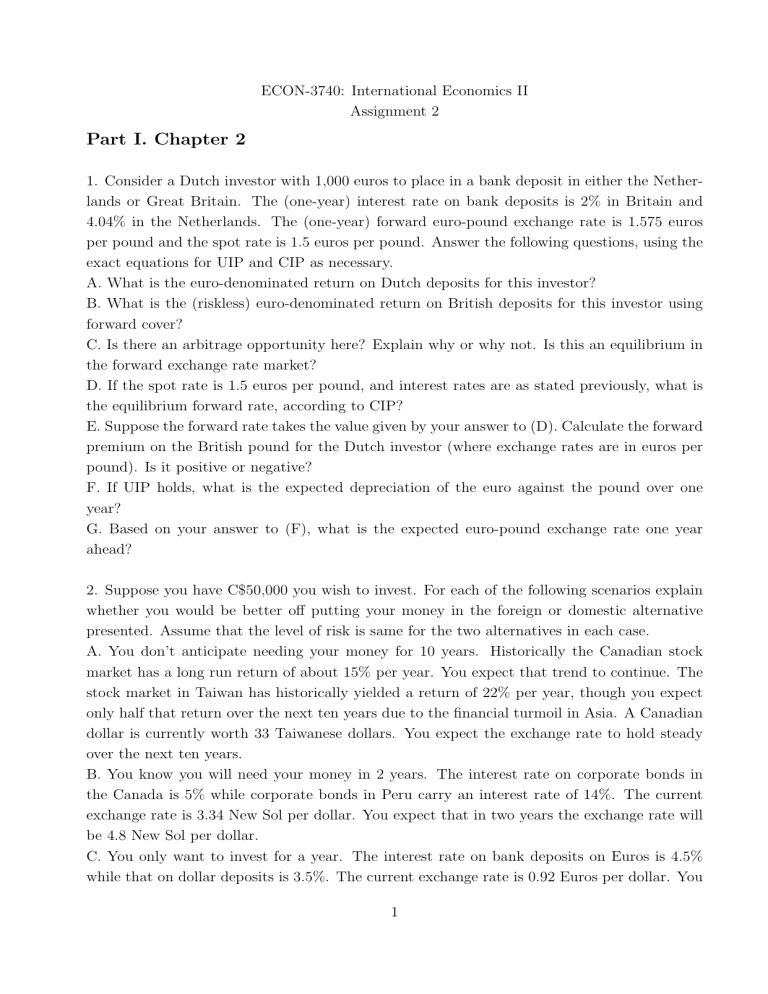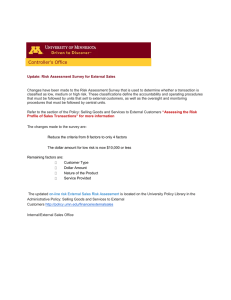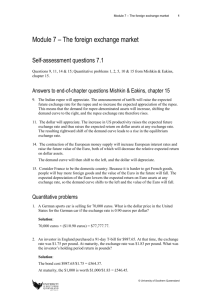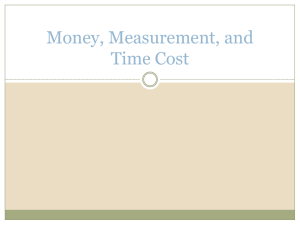
ECON-3740: International Economics II Assignment 2 Part I. Chapter 2 1. Consider a Dutch investor with 1,000 euros to place in a bank deposit in either the Netherlands or Great Britain. The (one-year) interest rate on bank deposits is 2% in Britain and 4.04% in the Netherlands. The (one-year) forward euro-pound exchange rate is 1.575 euros per pound and the spot rate is 1.5 euros per pound. Answer the following questions, using the exact equations for UIP and CIP as necessary. A. What is the euro-denominated return on Dutch deposits for this investor? B. What is the (riskless) euro-denominated return on British deposits for this investor using forward cover? C. Is there an arbitrage opportunity here? Explain why or why not. Is this an equilibrium in the forward exchange rate market? D. If the spot rate is 1.5 euros per pound, and interest rates are as stated previously, what is the equilibrium forward rate, according to CIP? E. Suppose the forward rate takes the value given by your answer to (D). Calculate the forward premium on the British pound for the Dutch investor (where exchange rates are in euros per pound). Is it positive or negative? F. If UIP holds, what is the expected depreciation of the euro against the pound over one year? G. Based on your answer to (F), what is the expected euro-pound exchange rate one year ahead? 2. Suppose you have C$50,000 you wish to invest. For each of the following scenarios explain whether you would be better off putting your money in the foreign or domestic alternative presented. Assume that the level of risk is same for the two alternatives in each case. A. You don’t anticipate needing your money for 10 years. Historically the Canadian stock market has a long run return of about 15% per year. You expect that trend to continue. The stock market in Taiwan has historically yielded a return of 22% per year, though you expect only half that return over the next ten years due to the financial turmoil in Asia. A Canadian dollar is currently worth 33 Taiwanese dollars. You expect the exchange rate to hold steady over the next ten years. B. You know you will need your money in 2 years. The interest rate on corporate bonds in the Canada is 5% while corporate bonds in Peru carry an interest rate of 14%. The current exchange rate is 3.34 New Sol per dollar. You expect that in two years the exchange rate will be 4.8 New Sol per dollar. C. You only want to invest for a year. The interest rate on bank deposits on Euros is 4.5% while that on dollar deposits is 3.5%. The current exchange rate is 0.92 Euros per dollar. You 1 expect the exchange rate to be 0.93 Euros per dollar a year from now. D. Suppose you read in the financial pages of the new paper that the interest rate on 90-days CANADIAN dollar deposit is 6% and the interest rate on 90-day Mexican peso deposit is 5%, and that the current exchange rate is 10 peso/C$. Assuming that uncovered interest rate parity holds and there is no risk, what must be the market’s expectation for the future exchange rate (peso/C$)? what should be the forward exchange rate? Part I. Chapter 3: Continued 1. Consider two countries, Japan and Korea. In 1996, Japan experienced relatively slow output growth (1%), whereas Korea had relatively robust output growth (6%). Suppose the Bank of Japan allowed the money supply to grow by 2% each year, whereas the Bank of Korea chose to maintain relatively high money growth of 12% per year. You will find it easiest to treat Korea as the home country and Japan as the foreign country. In addition, the bank deposits in Japan pay 3% interest; iU = 3%. A. Calculate the interest rate paid on Korean deposits. B. Calculate the expected rate of depreciation in the Korean Won relative to the Japanese Yen. C. Using the definition of the real interest rate (nominal interest rate adjusted for inflation), show that the real interest rate in Korea is equal to the real interest rate in Japan. D. Suppose the Bank of Korea increases the money growth rate from 12% to 15% and the inflation rate rises proportionately (one for one) with this increase. If the nominal interest rate in Japan remains unchanged, what happens to the interest rate paid on Korean deposits? Part II. Chapter 4 1. Use the money market and FX diagrams to answer the following questions about the relationship between the British pound (£) and the U.S. dollar ($). Let the exchange rate be defined as U.S. dollars per British pound, E$/£ . We want to consider how a change in the U.S. money supply affects interest rates and exchange rates. On all graphs, label the initial equilibrium point A. A. Illustrate how a temporary decrease in the U.S. money supply affects the money and FX markets. Label your short-run equilibrium point B. State how each of the following variables changes in the short run (increase/decrease/no change): U.S. interest rate, British interest e rate, E$/£ , E$/£ , and U.S. price level. B. Illustrate how a temporary increase in the British money supply affects the money and FX markets. Label your short-run equilibrium point B. State how each of the following variables changes in the short run (increase/decrease/no change): U.S. interest rate, British interest 2 e , and U.S. price level. rate, E$/£ , E$/£ 2. Use the money market and FX diagrams to answer the following questions. This question considers the relationship between the Indian rupees (Rs) and the U.S. dollar ($). Let the exchange rate be defined as rupees per dollar, ERs/$ . On all graphs, label the initial equilibrium point A. A. Illustrate how a permanent increase in India’s money supply affects the money and FX markets. Label your short-run equilibrium point B and your long-run equilibrium point C. B. By plotting them on a chart with time on the horizontal axis, illustrate how each of the following variables changes over time (for India): nominal money supply MIN , price level PIN , real money supply MIN /PIN , India’s interest rate iRs , and the exchange rate ERs/$ . C. Using your previous analysis, state how each of the following variables changes in the short e , and run (increase/decrease/no change): India’s interest rate, U.S interest rate, ERs/$ , ERs/$ India’s price level. D. Using your previous analysis, state how each of the following variables changes in the long run (increase/decrease/no change relative to their initial values at point A): India’s interest e rate, U.S interest rate, ERs/$ , ERs/$ and India’s price level. E. Explain how overshooting applies to this situation. 3





